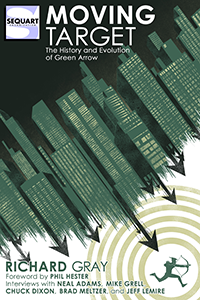A significant part of the new issue of Descender takes place fifteen years before the start of our main story, on a dusty old planet named “Ostrakon”. It’s a very clever and literate reference for Jeff Lemire to make in this, the final issue of the series’ first arc. Ostrakon is a Greek word referring to clay jars, but as high school ancient history tells us, it also refers to the way in which individuals were exiled from ancient Greek city-states. In what might be the ultimate example of societal shaming, the individual’s fate would subject to a popular vote, and citizens would write the name of the accused on shards of old jars (ostrakon). Depending on the outcome of the vote, the person could be forgiven or “ostracized” from the city-state. Back in those days, when life outside a settled urban environment meant being vulnerable to animals or hostile raiding gangs, that was essentially a death sentence. The layers of metaphor with Descender are rich indeed, particularly in this first sequence.
By simply evoking that ancient earth term, Lemire primes us to think of ancient history and ancient mysteries. It’s not a major spoiler to say that the occasion of this flashback is the visit to an archeological dig by a young graduate student named “Quon” and his supervisor, a renowned robotics scientist. They are there in order to analyze and study an ancient and seemingly far advanced robot, found in a temple that had not been in use for millions of years. An interesting modern parallel would be the “antikythera mechanism”, an extremely clever and precise geared machine that accurately predicts astronomical phenomenon, found on a sunken ship and dating to around 150-200 B.C.E.. The more we learn about the ancient past, the more advanced they seemed to be. And that certainly applies to Quon’s discovery and re-animation of this ancient robot, which awakes long enough to deliver one chilling message.
And of course we also have to think of the phenomenon of ostracism, and how that has applied not only to Dr Quon, who has long science retreated into shame, but of robots in general. For perhaps entirely understandable reasons, humans have developed a healthy fear of the machines that almost wiped out their civilization. The characters we’re following in the course of this story are all ostracized in one way or another, but seeking forgiveness and redemption in the harsh places outside the protection of city states (or, in Descender terms, the UGC).
But the most important thing, it seems to me, about the ancient robot story is that it explains Quon’s admission in the previous issue that he is a “fraud” and not any kind of genius, for developing the “codex” that powered the planet-destroying Harvester robots and TIM-21. He simply adapted it from this ancient robot, without truly understanding its nature or power.
So, metaphorically, we once again arrive at Prometheus (not the movie… the Greek legend) – a story of hubris and ego, and of a scientist who created (or stole) technology that was beyond his power to control, with disastrous consequences for all concerned. If Lemire had stopped his story here, it frankly would have been disappointing. This is rather well-trodden ground and I, and perhaps others, am rather tired of the “irresponsible scientist” trope. But luckily the story continues in significant ways after that rather predictable revelation, and re-focuses in the final panels on the themes that make Descender a great book: family, ancestry, and loyalty, as well as identity. TIM-21 and Dr Quon are, of course a father/son pair and think of themselves in that way. Quon’s identity was created by his ego and his fortune, and TIM’s identity is similarly artificial. Now that both characters have been stripped of much of their artifice (in Quon’s case, this is represented by physical mutilation), the revelations at the end of this issue open interesting doors in an already-interesting science fiction universe.
As always, Dustin Nguyen’s artwork is arresting and lyrical. His establishing panels of Ostrakon and his renderings of ancient caves and temples is as effective as anything committed to the screen (the Battlestar Galactica sequence involving the Tomb of Athena comes to mind), and Nguyen gets great milage out of silhouettes and back-lighting. His rendering of the ancient robot is also something of interest, a sort of cross between the half-destroyed Bishop from Alien 3, a dying Terminator and an all-too-disturbingly realistic Egyptian mummy, come to life. The pattern of gears in the head of the ancient robot deliberately resembles some of the visual patterns we’ve seen in previous issues, linking this robot to TIM-21in an interesting and subtle way. Steve Wands certainly has his hands full in this issue as well, creating entirely new kinds of lettering for an incomprehensible ancient alien language amongst his usual tasks.
As this arc of Descender draws to a close, Lemire seems to have been able to dispense with most of the tropes we’ve come to expect from science fiction stories and clear the proverbial decks such that he can move on and tell a more interesting story still in the upcoming issues. This is excellent, well-crafted science fiction that continues to be worth any reader’s time.






























































